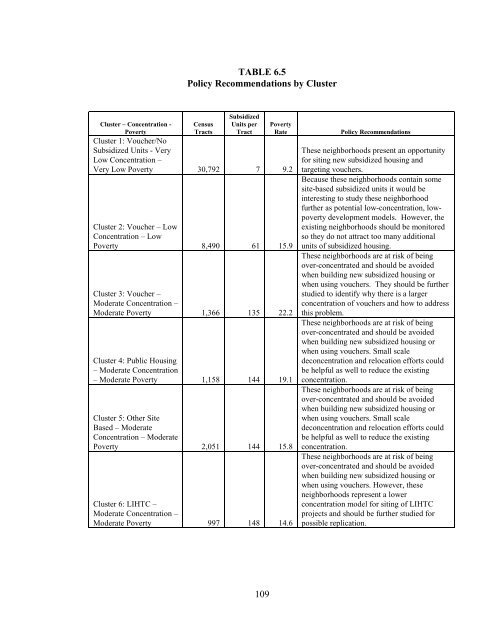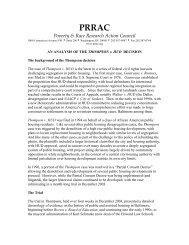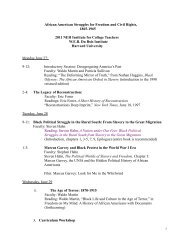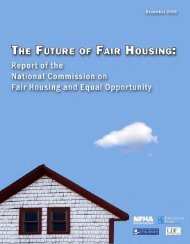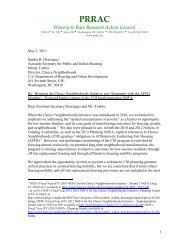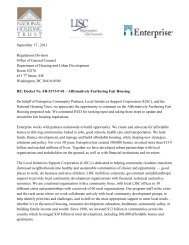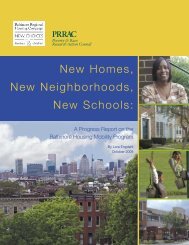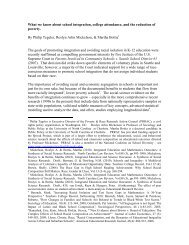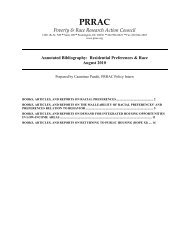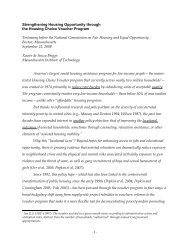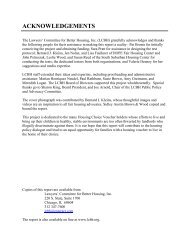The Spatial Concentration of Subsidized Housing - Poverty & Race ...
The Spatial Concentration of Subsidized Housing - Poverty & Race ...
The Spatial Concentration of Subsidized Housing - Poverty & Race ...
Create successful ePaper yourself
Turn your PDF publications into a flip-book with our unique Google optimized e-Paper software.
TABLE 6.5Policy Recommendations by ClusterCluster – <strong>Concentration</strong> -<strong>Poverty</strong>CensusTracts<strong>Subsidized</strong>Units perTract<strong>Poverty</strong>RateCluster 1: Voucher/No<strong>Subsidized</strong> Units - VeryLow <strong>Concentration</strong> –Very Low <strong>Poverty</strong> 30,792 7 9.2Cluster 2: Voucher – Low<strong>Concentration</strong> – Low<strong>Poverty</strong> 8,490 61 15.9Cluster 3: Voucher –Moderate <strong>Concentration</strong> –Moderate <strong>Poverty</strong> 1,366 135 22.2Cluster 4: Public <strong>Housing</strong>– Moderate <strong>Concentration</strong>– Moderate <strong>Poverty</strong> 1,158 144 19.1Cluster 5: Other SiteBased – Moderate<strong>Concentration</strong> – Moderate<strong>Poverty</strong> 2,051 144 15.8Cluster 6: LIHTC –Moderate <strong>Concentration</strong> –Moderate <strong>Poverty</strong> 997 148 14.6Policy Recommendations<strong>The</strong>se neighborhoods present an opportunityfor siting new subsidized housing andtargeting vouchers.Because these neighborhoods contain somesite-based subsidized units it would beinteresting to study these neighborhoodfurther as potential low-concentration, lowpovertydevelopment models. However, theexisting neighborhoods should be monitoredso they do not attract too many additionalunits <strong>of</strong> subsidized housing.<strong>The</strong>se neighborhoods are at risk <strong>of</strong> beingover-concentrated and should be avoidedwhen building new subsidized housing orwhen using vouchers. <strong>The</strong>y should be furtherstudied to identify why there is a largerconcentration <strong>of</strong> vouchers and how to addressthis problem.<strong>The</strong>se neighborhoods are at risk <strong>of</strong> beingover-concentrated and should be avoidedwhen building new subsidized housing orwhen using vouchers. Small scaledeconcentration and relocation efforts couldbe helpful as well to reduce the existingconcentration.<strong>The</strong>se neighborhoods are at risk <strong>of</strong> beingover-concentrated and should be avoidedwhen building new subsidized housing orwhen using vouchers. Small scaledeconcentration and relocation efforts couldbe helpful as well to reduce the existingconcentration.<strong>The</strong>se neighborhoods are at risk <strong>of</strong> beingover-concentrated and should be avoidedwhen building new subsidized housing orwhen using vouchers. However, theseneighborhoods represent a lowerconcentration model for siting <strong>of</strong> LIHTCprojects and should be further studied forpossible replication.109


